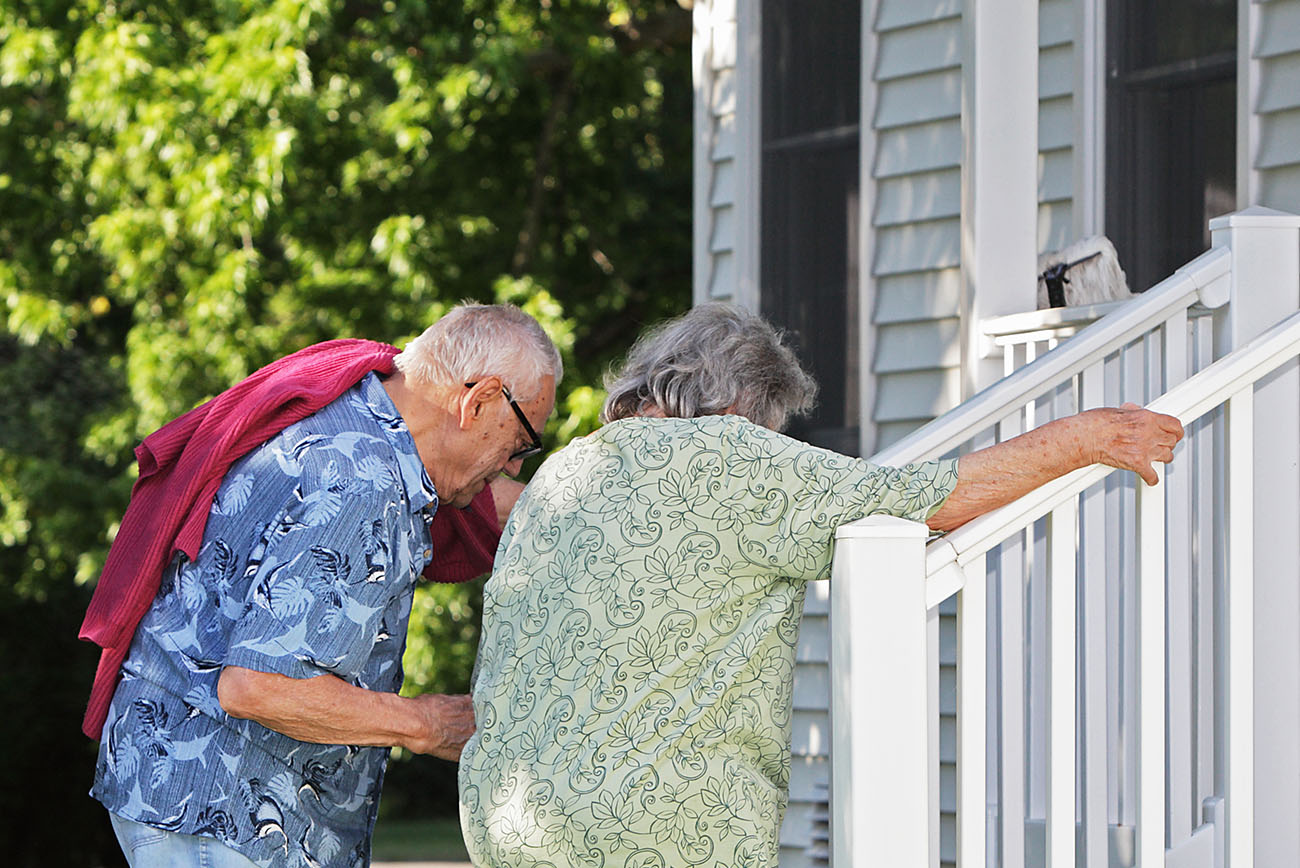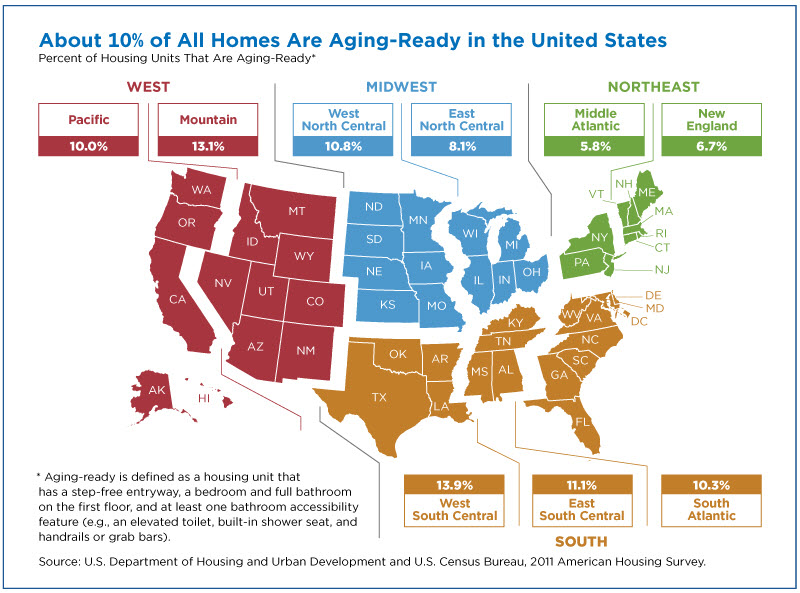Is America’s Housing Ready for an Aging Population?
It should come as no surprise that older Americans overwhelmingly want to stay in their home as they age. But are their homes ready for them to stay?
For millions of older Americans, home is where they raised a family, hosted holidays and told bedtime stories to their children and grandchildren. It is often their nest egg as well as an anchor to their community.
But older homes don’t always meet the needs of older Americans, according to a new report from the U.S. Census Bureau.
Of the nation’s 115 million housing units, only 10% are ready to accommodate older populations.
Only 10% of U.S. homes have key features to accommodate older residents, according to the report: Old Housing, New Needs: Are U.S. Homes Ready for an Aging Population?
The report looks at the number of homes in the United States that have aging-accessible features as well as households with older adults who have difficulty using some aspect of their home.
Need for Aging-Ready Housing Growing
Over the next 10 years, the size of the population 65 and older is projected to grow by 17 million as baby boomers age. By 2030, an estimated 1 in 5 Americans will be 65 and older.
As the number of older Americans grows, how the design, function and layout of homes affect older people’s ability to live safely at home becomes paramount.
Every year, about 30 million older people fall in the United States – one fall every second of every day.
According to the Centers for Disease Control and Prevention (CDC), around 1 in 5 of these falls results in serious harm. The direct medical costs of fall-related injuries total more than $50 billion annually.
Nearly 11 million older Americans have serious difficulty walking or climbing stairs; 7 million have trouble living on their own; and almost 4 million have difficulty bathing or dressing themselves.
Yet most homes are not equipped to handle the needs of adults with these difficulties.
Only 1 in 10 U.S. Homes Aging-ready
Of the nation’s 115 million housing units, only 10% are ready to accommodate older populations.
For example, only 1 in 10 homes have a step-free entryway, a bedroom and full bathroom on the first floor so older adults do not need to use the stairs, and at least one bathroom accessibility feature such as handrails or a built-in shower seat.
Aging-ready homes are even less common in some areas of the country. In the Mid-Atlantic region, which includes New York, Pennsylvania and New Jersey, only 6% of homes are aging-ready. In comparison, about 14% of homes age aging-ready in the West South Central area of the country, including Arkansas, Louisiana, Oklahoma, and Texas.
Steps, Stairways, Bathrooms Are a Challenge
Often a place of convenience and comfort, the home also poses risks for older adults’ safety and well-being.
More than a quarter of all households with an adult age 65 or older reported trouble using some feature of the home. Among households with adults 85 and over, that figure rises to nearly half.
Steps and stairways are by far the most common problem areas in the home for older adults. A quarter of older households reported such difficulty.
Bathrooms pose considerable risks as well and are the second most common problem area of the home for older adults. More than half of bathroom injuries are directly related to using the shower and getting into or out of the bathtub, according to the CDC.
Installing handrails, grab bars and built-in shower seats in the bathroom could help reduce risk for older adults and improve the safety of their home.
These data are produced by the U.S. Commerce Department's Census Bureau from a survey sponsored by the U.S. Department of Housing and Urban Development.
Jonathan Vespa is a demographer in the U.S. Census Bureau’s Social, Economic, and Housing Statistics Division.
-
Stats for StoriesAmerican Housing Month: June 2023The 2021 American Community Survey counted 142.15M housing units, up 3.61M from 2018, and up 10.36M from 131.79M in 2010.
-
Stats for StoriesOlder Americans Month: May 2023The 2021 American Community Survey estimated there were 55,892,014 people aged 65 and over in the U.S. out of a total population of 331,893,745, or 16.8%.
Subscribe
Our email newsletter is sent out on the day we publish a story. Get an alert directly in your inbox to read, share and blog about our newest stories.
Contact our Public Information Office for media inquiries or interviews.
-
America Counts StoryHow Census Bureau Data Can Help Older Americans Afford HousingNovember 27, 2018King County, Wash., increased enrollment in a housing affordability program for older Americans using the American Community Survey.
-
America Counts StoryBy 2030, All Baby Boomers Will Be Age 65 or OlderDecember 10, 2019The 2020 Census will provide the most up-to-date information on the wave of an estimated 73 million aging baby boomers to policymakers.
-
America Counts StoryOlder Population in Rural AmericaOctober 22, 2019A new report shows that more than 1 in 5 older Americans live in rural parts of the country.
-
Business and EconomyWhat Is the Nonemployer Marine Economy?April 09, 2025Thirty states had nonemployer businesses in marine economy sectors, including six states in the Midwest with receipts totaling nearly $11 billion in 2022.
-
Business and EconomyEconomic Census Geographic Area Statistics Data Now AvailableApril 07, 2025A new data visualization based on the 2022 Economic Census shows the changing business landscape of 19 economic sectors across the United States.
-
Income and PovertyWhat Sources of Income Do People Rely On?April 02, 2025A new interactive data tool shows income sources for hundreds of demographic and economic characteristic combinations.
-
Business and EconomyBig Improvements to the Annual Integrated Economic Survey (AIES)March 26, 2025The Census Bureau is making several changes and enhancements to capture 2024 economic data based on feedback from last year’s survey.







